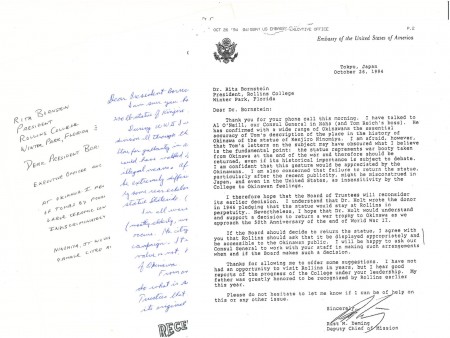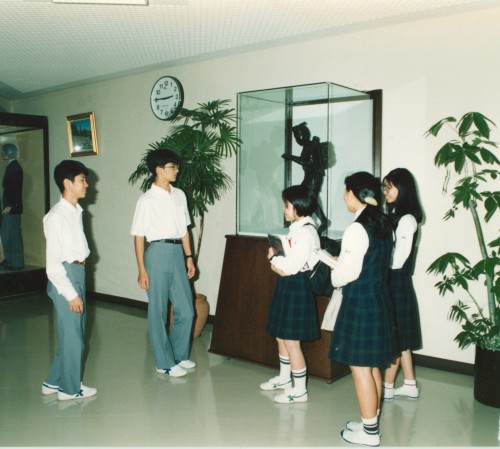 President Hamilton Holt with the statue of Ninomiya Kinjiro in 1946
President Hamilton Holt with the statue of Ninomiya Kinjiro in 1946
In February 1946, Rollins graduate and World War II veteran Clinton Nichols ’34 wrote to President Holt, telling him about an artifact found by U.S. Marines when they were cleaning out a well in Okinawa, looking for drinking water. Hidden in the well was a bronze statue of Ninomiya Kinjiro (1787-1856) as a boy, reading the sayings of Confucius while carrying a bundle of twigs. Though born to a peasant family, he became a wealthy agricultural leader, economist, and philosopher, and his statue was often placed in schools to encourage others to follow his example of constant study.
The U.S. Navy had given Mr. Nichols permission to take the statue back to the States, and he wrote Pres. Holt, “I am so thrilled with it.” Then he asked, “WOULD YOU LIKE IT AS A GIFT FOR ROLLINS?” After the statue arrived, Pres. Holt wrote in his thank-you letter, “to say we are delighted with it is putting it mildly. . . That was a fine present to your Alma Mater.”
The statue was placed in a niche in the College’s new Administration Building. Years went by with no questions asked, until 1983 when a student approached Pres. Thaddeus Seymour to ask why Rollins was exhibiting war booty. Very little information was available about the statue, so when his former assistant made a trip to Japan in 1993, Pres. Seymour asked her to look into the matter. Soon afterwards, a letter from the Ryukyu America Historical Research Society in Okinawa arrived in the office of Rollins’ new President, Rita Bornstein, asking for the College’s help in returning the statue to its original home.
After consulting a number of people, including government officials, Rollins faculty, alumni, and students, Pres. Bornstein wrote that the College’s trustees had decided to keep the statue. Several factors led to this decision, among them the fact the Rollins had legal ownership, and the opinion of the Consul that the statue had little cultural value to Okinawans. There was also the wish to honor Pres. Holt’s promise to the donor that the statue would always remain here.
A controversy erupted after this was reported in The New York Times (http://www.nytimes.com/1994/10/24/arts/okinawa-seeks-return-of-statue.html). Pres. Bornstein received letters from all over the country asking the College to reconsider, including several from veterans of the Battle of Okinawa, a conflict that had lasted 82 days and cost thousands of lives (both military and civilian). One letter from a former Naval officer read in part, “In April, 1945, my ship was stationed at Okinawa. I personally observed the unwarranted desecration of tombs by poorly supervised Marines and army personnel. . . Please return the statue of Kinjiro Ninomiya. It would be a small recompense for the needless damage cited above.” Another veteran of the battle wrote, “In all wars the people who suffer most are the citizens (mostly elderly, women & children) in the country where the conflict occurs. The citizens of Okinawa suffered greatly during the campaign. It is unimportant whether the statue has cultural value or not. My belief is that the statue belongs to the citizens of Okinawa.” Soon afterward, the Executive Committee of the Board of Trustees met again, and decided that “in a spirit of friendship and reconciliation, Rollins College shall return the Ninomiya statue in commemoration of the 50th anniversary of the end of World War II.”
Some of the letters written to Pres. Bornstein
The statue went back to its home in Okinawa, where it is displayed at Okinawa Shogaku Gakuen, a private secondary school (below).
And in its place Rollins received a beautiful replica from the Ryukyu America Historical Research Society. Normally housed in the lobby of the Administration Building, the replica is currently on display at the Cornell Fine Arts Museum, as part of an exhibit highlighting issues surrounding cultural property.
Today Rollins has an exchange program with Okinawa Shogaku Gakuen, and ties between both institutions continue to flourish–a real illustration of the Japanese proverb “ichiryu manbai” (“a single seed will multiply ten thousand fold”).
~ by D. Moore, Archival Specialist
For more information on the Museum exhibit, see http://www.rollins.edu/cfam/exhibitions/index.html . To read Dr. Bornstein’s account of this chapter in Rollins’ history, visit http://chronicle.com/article/How-a-College-Got-Embroiled-in/100126/. And for information about the exchange program with Okinawa Shogaku, please see http://tars.rollins.edu/int-programs/ARCHIVE/okinawa.html .



AS A INTERIOR DESIGNER I PURCHASED THIS SAME FIGURE FOR MY CLIENT AT A ANTIQUE SHOWROOM IN THE CHICAGO MERCHANDISE MART IN THE LATE SIXTIES. AFTER HER DEATH IN 2002 HER NEPHEW SENT IT BACK TO ME WITH A NOTE THAT SAID HIS AUNT ALWAYS WANTED ME TO HAVE IT.
I NEVER KNEW ANYTHING ABOUT IT BEFORE RESEARCHING IT NOW.
THANKS
SINCERELY
ROBERT W. SMITH ASID